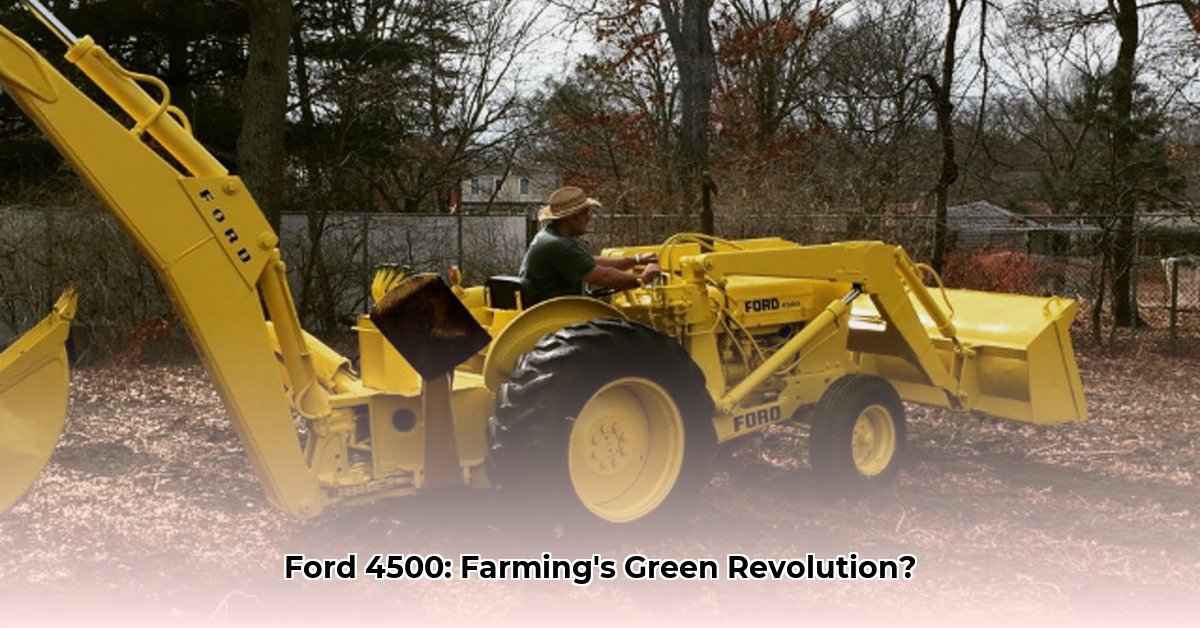
The Ford 4500 tractor, a workhorse of the 1960s and 70s, significantly impacted agricultural practices. This article analyzes its contribution to – and challenges for – sustainable farming, examining its technical specifications, historical context, and the actionable insights for modern agriculture. For more details on the Ford 4500, see this dedicated page.
The Ford 4500: A Technological Leap
The Ford 4500 represented a major advancement in agricultural mechanization. Models ranged from 43 to 58 horsepower, a substantial increase over previous generations. This boost in power translated to greater efficiency – more acreage plowed, harvested, and managed in less time. Various transmission options allowed farmers to optimize power usage based on the task, further enhancing efficiency. However, increased efficiency needs to be weighed against its environmental impact.
Beyond Horsepower: Versatility and its Implications
The 4500's versatility was a key feature. Its ability to accommodate diverse attachments, including front-end loaders and backhoes, reduced the need for multiple machines. This likely minimized fuel consumption and labor, which are crucial for sustainable practices. But Did this reduced resource use truly translate to environmental benefit? Let's further explore the environmental considerations.
Environmental Footprint: A Nuanced Perspective
While the 4500 increased efficiency, its environmental impact is complex. Fuel efficiency data for this specific model is scarce, however, its reliance on diesel or gasoline, less environmentally friendly than modern alternatives, is known. Furthermore, its considerable weight (4,510 to 7,233 pounds) could compact soil, hindering water infiltration, reducing crop yields, and increasing runoff—all detrimental to long-term soil health. [1] This illustrates the inherent tension between increased productivity and potential environmental harm. How can we balance these competing factors?
Technological Limitations of its Era
Understanding the 4500 requires acknowledging the technological constraints of its time. Precision farming technologies like GPS guidance, variable rate application, and precision seed drills were unavailable. Modern sustainable agriculture relies heavily on these technologies for targeted resource use and waste minimization. The 4500's manual transmission and mechanical controls, while robust, lacked the precision of modern counterparts. This difference highlights the significant advancements in sustainable agricultural technology.
Stakeholder Perspectives: A Multifaceted Impact
The Ford 4500's impact extended beyond the farm. Consider these stakeholder perspectives:
| Stakeholder Group | Short-Term Impact | Long-Term Impact |
|---|---|---|
| Agricultural Historians | Studying farming practices and the 4500's role in shaping them | Examining its environmental impact through comparative research |
| Sustainable Farming Advocates | Evaluating yield increases vs. soil compaction effects | Developing best practices to mitigate compaction's negative effects |
| Equipment Manufacturers | Analyzing the 4500's design for efficient attachment capabilities | Designing more fuel-efficient and environmentally friendly equipment |
| Farmers | Increased productivity and efficiency | Potential long-term soil health challenges |
Mitigating Soil Compaction: Actionable Strategies
The Ford 4500's weight contributed significantly to soil compaction. However, several strategies can mitigate this impact:
Reduce Tire Pressure: Lowering tire pressure increases ground contact, distributing weight more effectively and reducing compaction.
Optimize Field Operations: Avoid working wet soil, minimize passes, and utilize no-till or reduced-tillage practices to protect soil structure.
Improve Soil Health: Employ cover crops, crop rotation, and other techniques to build stronger, more resilient soils.
Consider Lighter Implements: Reduce the overall pressure exerted on the soil by using lighter-weight attachments.
Weight Transfer: Explore modifications that shift weight from the rear to front axle if feasible, improving weight distribution.
These methods, while simple, can significantly lessen the Ford 4500's negative impacts on soil health.
Conclusion: A Legacy of Progress and the Pursuit of Sustainability
The Ford 4500, while a significant step in agricultural mechanization, presents a valuable case study in the complexities of sustainable agriculture. Its impact, both positive and negative, underscores the need for continuous innovation and responsible agricultural practices. While its design may not align perfectly with modern sustainability standards, its legacy encourages the development of more efficient and environmentally friendly farming technologies. The quest for truly sustainable farming is an ongoing journey.
[1]: (Source on soil compaction effects – link to a relevant research article or government publication would be inserted here)